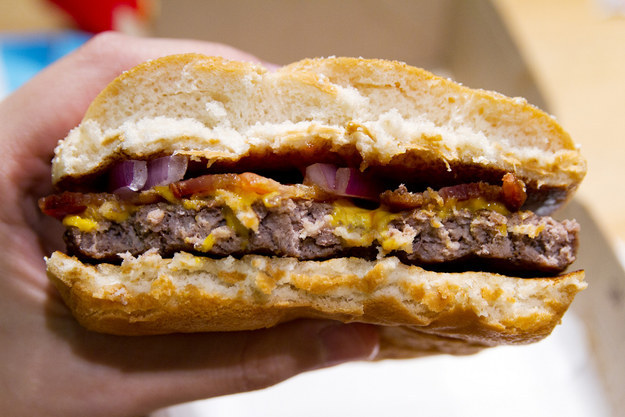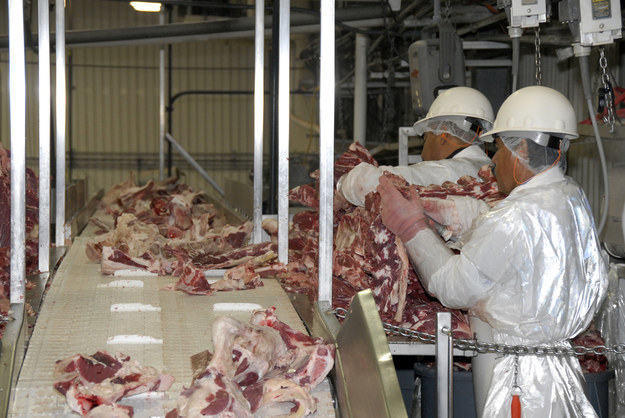Meat That Tests Positive For E. Coli Is Cooked And Sold In Human And Pet Food — BuzzFeed
Meat That Tests Positive For E. Coli Is Cooked And Sold In Human And Pet Food
And this might not be such a bad thing.
posted on May 29, 2014, at 12:32 p.m.
Deena Shanker BuzzFeed Staff
Pre-cooked meat, like the patties used in fast food burgers, may have once tested positive for pathogens such as E. coli. Flickr: roboppy
The USDA and food processing company employees continuously test raw meat for pathogens such as E. coli before it is distributed to the public.
But when a batch tests positive, the meat does not necessarily get thrown away. It can be cooked according to a USDA-approved method then sold as processed food that you’d find in a supermarket freezer aisle, at a fast-food chain, or as pet food. Many Americans — and even several food experts contacted by BuzzFeed — are unaware that a secondary market for pathogen-tainted meat exists (or that it is regularly processed into safe, consumable food). But because the process is considered safe, even by consumer awareness experts, and uses meat that would otherwise go to a landfill, many see it as an efficient and economically savvy method of reducing waste. The existence of the secondary market for tainted meat, however, points to weakness in an increasingly industrialized and consolidated food system as industry leaders will not share information about how much meat is processed this way.
Since 1998, the USDA’s Food Safety and Inspection Service (“FSIS”) has required every slaughterhouse and processing plant in the U.S. to have a Hazard Analysis and Critical Control Points (“HACCP”) plan to handle and reduce occurrences of “food safety hazards.” One type of hazard addressed by these plans is the appearance and spread of pathogens such as E. coli. Under HACCP, companies are required to continuously sample and test the meat in their facilities. If a sample tests positive for a pathogen, the company has the option of cooking the meat for a specific length of time and at a specific temperature, proven to kill it (called the “lethality step”). This process is scientifically validated and FSIS-approved as safe. Not all slaughterhouses and processors have the resources for this kind of cooking, though, so they can sell their tainted meat to another facility that does.
The meat can also be rendered into pet food through a process that involves collecting the meat, adding heat to it and then removing and straining all the resulting liquid to leave behind a “meal” of fat, bone, and protein.
Workers at the Sam Kane beef slaughterhouse in Corpus Christi, Texas on June 10, 2008 dissect, sort and separate beef parts. USDA FSIS inspectors are on site to ensure the beef is processed in accordance with regulations. Flickr: usdagov / USDA / Alice Welch
It is difficult to gauge the size of this secondary market. The USDA told BuzzFeed that it does not specifically track these numbers, but is in the process of collecting the information to respond to our request. A spokesperson for American Meat Institute, the largest trade association representing the U.S. meat and poultry industry interests, said the organization “certainly [doesn’t] track that,” and that she is “guessing the data doesn’t exist.”
Customers cannot differentiate between a cooked product that is made from meat that once tested positive for a pathogen and one that is made from meat that was always safe because large food companies do not need to inform customers about whether its meat has undergone an FSIS-approved process to kill contaminants (or disclose who supplies their meat).
Colorized low-temperature electron micrograph of a cluster of E. coli bacteria Flickr: microbeworld
Food safety experts agree with the USDA that the process is safe.
“We don’t have a problem with this approach because it means that companies are at least testing and if they find E. coli then they are rendering the product fit for consumption,” says Christopher Waldrop, Director of the Food Policy Institute at the Consumer Federation of America. “By cooking the product, the company is destroying the pathogens and preventing consumers from being exposed to contaminated product. That’s a good thing.”
However, meat processors like Mike Callicrate of Ranch Foods Direct says effective prevention of pathogens is better practice than killing them when they appear. Callicrate has been operating his processing facility since June 2000 and says his products have never had a positive E. coli test, in his meat or even in his animals’ feces where E. coli originates. He attributes this to several factors, including the size of his operation — at most, he only processes up to 20 head per day as compared to 6,000 for a large plant — a better diet and a zero-mile distance traveled between his feedlot and slaughter unit as opposed to the 600+ miles traveled by some conventionally raised cattle.



